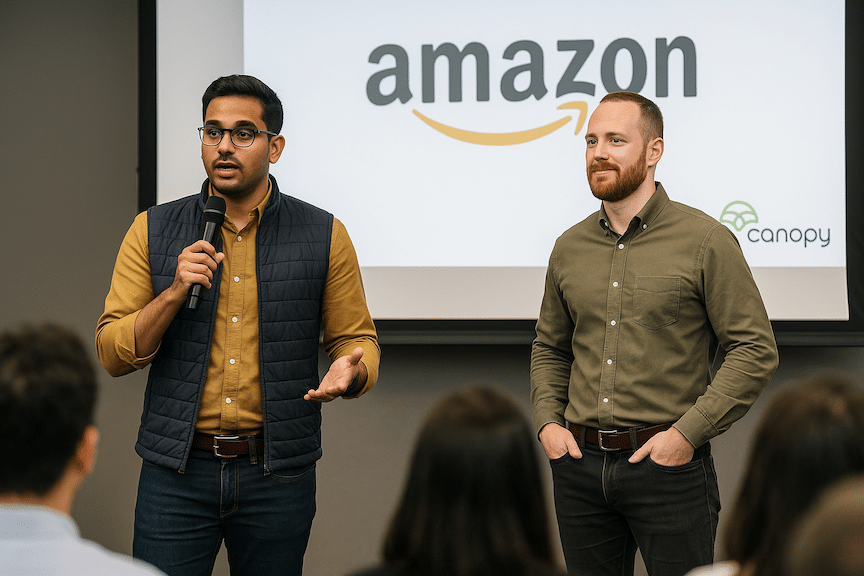Where Do New Amazon Product Ideas Come From in 2025?
Discover how AI-powered research, supply chain evolution, and systematic validation are replacing old-school product sourcing methods in 2025

The Amazon marketplace has evolved dramatically. Gone are the days when sellers could simply browse Alibaba, find a trending product, and ride the wave to success. In 2025, winning product ideas emerge from a sophisticated blend of AI-powered insights, cultural moments, and strategic market positioning.
The Death of “Me Too” Products
Let’s be brutally honest: if you’re still looking for the next fidget spinner or phone case variation, you’re already five years behind. Today’s successful Amazon products solve specific problems for clearly defined audiences. They’re born from genuine market gaps, not from copying what’s already selling.
The most profitable products on Amazon right now weren’t discovered—they were engineered. They came from sellers who understood that modern product development is about anticipation, not replication.
AI Has Changed Everything (But Not How You Think)
While everyone’s talking about using ChatGPT to write product listings, the real AI revolution in product discovery is happening behind the scenes. Here’s what smart sellers are actually doing:
Predictive Demand Modeling
Sophisticated sellers are using AI tools that analyze search patterns, social media conversations, and even economic indicators to predict what consumers will want 3-6 months from now. These aren’t the basic keyword tools from 2020—we’re talking about systems that can identify emerging micro-trends before they hit mainstream consciousness.
Problem Mining at Scale
AI systems now scan millions of product reviews, Reddit threads, and social media complaints to identify unmet needs. When thousands of people complain about the same issue with existing products, that’s not noise—that’s opportunity.
Cultural Trend Synthesis
The best products of 2025 sit at the intersection of multiple trends. AI helps identify when disparate movements—like sustainability, minimalism, and smart home technology—create opportunities for entirely new product categories.
Ready to Start Growing Your Amazon Brand?
Canopy’s Partners Achieve an Average 84% Profit Increase!
Find out moreWhere Today’s Winners Actually Find Ideas
The TikTok-to-Amazon Pipeline
Despite regulatory uncertainty, TikTok remains a goldmine for product discovery. But it’s not about finding viral products—it’s about understanding the problems behind the trends. When viewers engage with “get ready with me” videos by the thousands, smart sellers don’t just see makeup sales. They see opportunities for better organization systems, innovative lighting solutions, and time-saving tools.
The Subscription Box Intelligence Method
Successful subscription boxes are essentially curated market research. By analyzing what appears consistently across multiple successful boxes, sellers can identify products with proven demand but limited Amazon presence. The key is looking for items that solve recurring problems—things people need regularly but hate shopping for.
The B2B Crossover Strategy
Some of the most successful Amazon products of 2025 are simplified versions of professional tools. Industrial-grade solutions adapted for consumer use often find massive markets. Think professional kitchen equipment scaled for home cooks, or contractor tools reimagined for DIY enthusiasts.
For a deep dive into traditional sourcing methods and how they’ve evolved, check out our guide on Alibaba.
The Supply Chain Revolution
Finding great product ideas is only half the battle. The real challenge in 2025 is executing on those ideas profitably. With Chinese imports facing significant headwinds, winning sellers have adapted:
Regional Manufacturing Networks
Instead of relying on a single country, successful sellers now work with manufacturing networks spanning Vietnam, India, Mexico, and Eastern Europe. Each region offers specific advantages—Vietnam for electronics assembly, India for textiles and natural products, Mexico for quick-turn items targeting North America.
Micro-Batch Testing
The days of ordering 5,000 units for your first run are over. Smart sellers now use regional manufacturers who can produce 100-500 unit test batches. This allows for rapid iteration based on real customer feedback before making major inventory commitments.
Direct-to-Consumer Intelligence
Many successful Amazon sellers now launch products on their own Shopify stores first. This provides invaluable data about customer preferences, price sensitivity, and feature requests—all before investing in large-scale Amazon inventory.

The Problems Worth Solving in 2025
The best product ideas address specific pain points that have emerged or intensified recently:
The Remote Work Ecosystem
Despite return-to-office mandates, millions still work from home regularly. Products that solve specific remote work challenges—beyond basic desk accessories—continue to find eager markets.
The Sustainability Paradox
Consumers want eco-friendly products but won’t sacrifice convenience. Products that thread this needle—offering genuine environmental benefits without requiring behavior change—are winning big.
The Simplification Movement
As life gets more complex, products that genuinely simplify daily tasks command premium prices. But “simple” doesn’t mean “basic”—it means thoughtfully designed solutions that eliminate friction.
The Loneliness Economy
Products that facilitate genuine human connection or address social isolation are seeing unprecedented demand. This isn’t just about games or communication devices—it’s about anything that helps people feel less alone.
Why Most Product Research Fails
Here’s what separates successful product launches from the majority that fail:
Solving Your Own Problems Isn’t Enough
Just because you’d buy something doesn’t mean there’s a market. Successful products solve problems for specific, reachable audiences who are already spending money on inferior solutions.
Features Don’t Sell Products
Benefits do. The most innovative features mean nothing if they don’t translate to clear, immediate benefits that customers can understand in seconds.
Perfect Is the Enemy of Profitable
The sellers crushing it in 2025 launch “good enough” products quickly, then iterate based on customer feedback. By the time competitors catch up, they’re already on version 3.0.
The Uncomfortable Truth About Innovation
Real product innovation in 2025 isn’t about inventing something entirely new. It’s about:
- Taking existing solutions and making them 10x better for a specific audience
- Combining features from multiple products into one thoughtful solution
- Removing unnecessary complexity from overcomplicated products
- Adding intelligence to “dumb” products in ways that actually matter
Your Next Steps
Finding your next winning product isn’t about having access to secret suppliers or proprietary data. It’s about developing a systematic approach to identifying and validating opportunities. Here’s where to start:
- Choose your lens: Pick 2-3 major trends or problem areas you understand deeply
- Set up your intelligence network: Use AI tools to monitor these areas continuously
- Validate ruthlessly: Every idea should pass through multiple validation filters before you invest
- Start small, fail fast: Use micro-batches and rapid testing to validate demand
- Build manufacturing flexibility: Develop relationships with multiple suppliers across different regions
The sellers winning on Amazon in 2025 aren’t the ones with the best products—they’re the ones with the best systems for continuously identifying and launching new products.

Frequently Asked Questions
What’s changed in Amazon product research since 2020?
The landscape has shifted dramatically. Traditional Alibaba-to-Amazon arbitrage no longer works due to increased competition, tariffs, and market saturation. Today’s successful sellers use AI-powered predictive analytics, multi-regional supply chains, and systematic validation processes. The focus has moved from finding trending products to engineering solutions for specific market gaps.
How can AI help me find profitable Amazon products?
AI tools now analyze millions of data points to predict trends 60-90 days before they peak. They scan product reviews, social media complaints, and search patterns to identify unmet needs. More importantly, AI helps synthesize multiple cultural trends to spot opportunities for entirely new product categories—not just variations of existing products.
Is TikTok Shop still relevant for product discovery in 2025?
Despite regulatory challenges, TikTok remains valuable for understanding consumer problems and emerging needs. The key isn’t copying viral products but analyzing why certain solutions resonate. When thousands engage with specific content types, it reveals underlying market opportunities that extend beyond the platform itself.
What are micro-batch testing strategies?
Micro-batch testing involves ordering 100-500 units from regional manufacturers instead of traditional 5,000-unit minimum orders. This allows you to test market response, gather real customer feedback, and iterate quickly before making major inventory investments. It’s particularly effective when combined with initial launches on your own Shopify store.
Which countries should I consider for manufacturing beyond China?
Successful sellers now diversify across multiple regions: Vietnam for electronics assembly, India for textiles and natural products, Mexico for quick-turn North American delivery, Turkey and Portugal for fashion with shorter lead times, and Eastern Europe for specialized manufacturing. Each region offers specific advantages based on product type and target market.
What makes a product idea worth pursuing in 2025?
Winning products solve specific, validated problems for defined audiences who are already spending money on inferior solutions. They sit at the intersection of multiple trends, offer clear benefits (not just features), and can be improved through iteration. Most importantly, they address emerging pain points like remote work challenges, sustainability without sacrifice, or genuine human connection.
How do I validate a product idea before investing?
Start by launching on your own DTC store to gather data on customer preferences and price sensitivity. Use AI tools to analyze competitor reviews and market gaps. Order micro-batches for testing, and ensure your idea passes multiple validation filters: market demand, profitable unit economics, manageable competition, and alignment with current trends.
What’s the biggest mistake sellers make in product research?
Most sellers fail by trying to solve their own problems without validating broader market demand. They focus on features instead of benefits, chase perfection instead of launching quickly and iterating, or rely on single suppliers without building redundancy. The key is developing systematic approaches rather than hoping for one-off wins.
How important is supply chain diversification?
Critical. With ongoing tariff changes and geopolitical uncertainty, relying on a single country or supplier is risky. Successful sellers maintain relationships with 2-3 suppliers across different regions, typically allocating 40-50% to a primary supplier, 30-40% to a secondary source, and 10-20% for emergency backup.
Can I still succeed without using AI tools?
While possible, you’ll be at a significant disadvantage. AI tools provide speed and scale in identifying opportunities that manual research can’t match. They help predict trends, analyze vast amounts of customer feedback, and optimize decision-making. Think of AI as a force multiplier for your existing expertise, not a replacement for strategic thinking.
Ready to Transform Your Product Strategy?
The landscape has changed dramatically, but one thing remains constant: success on Amazon requires expertise, technology, and relentless execution. Whether you’re launching your first product or your fiftieth, having the right guidance makes all the difference.
At Canopy Management, we’ve developed a systematic approach to helping brands navigate this new complexity. Our Custom Brand Plan™ provides a clear roadmap tailored to your specific situation and goals.
Ready to discover what’s possible for your brand? Let’s talk.
Canopy Management is a full-service marketing agency for Amazon, Walmart, and TikTok sellers. Our team consists of multi-million dollar, omni-channel entrepreneurs, industry leaders, and award-winning experts.
Ready to Start Growing Your Amazon Brand?
Canopy’s Partners Achieve an Average 84% Profit Increase!
Find out more

